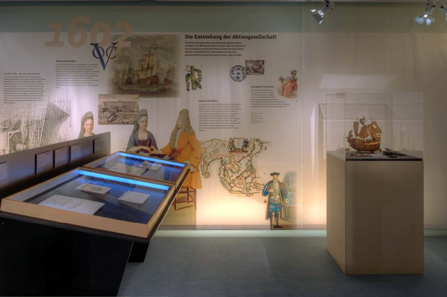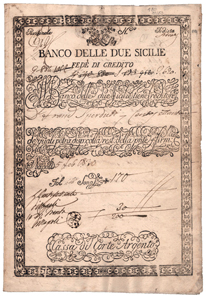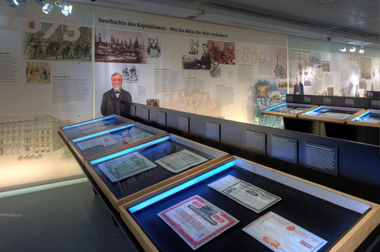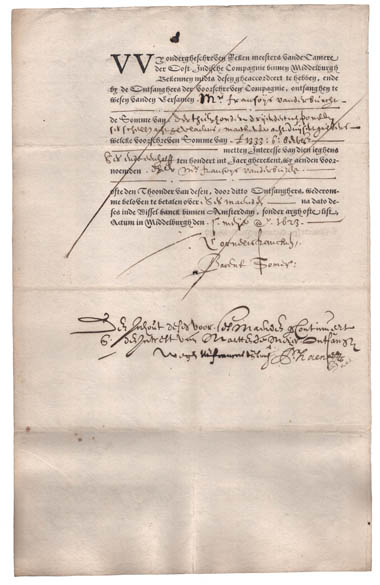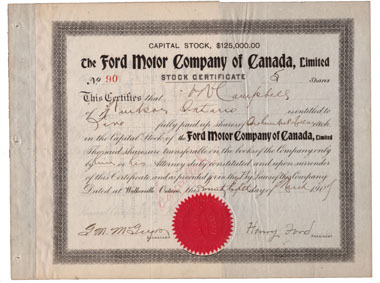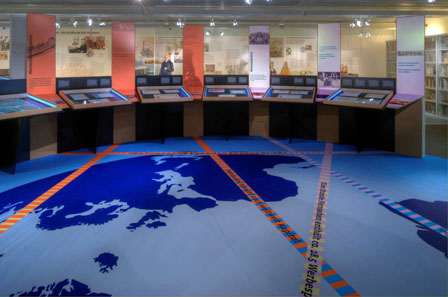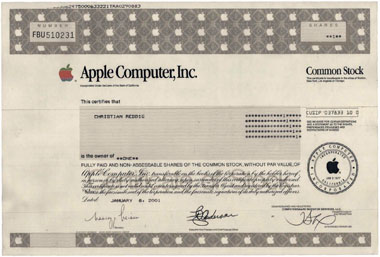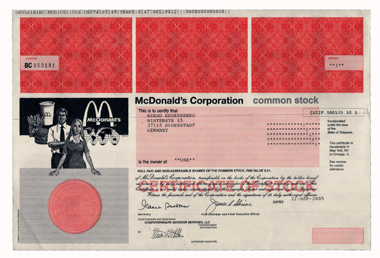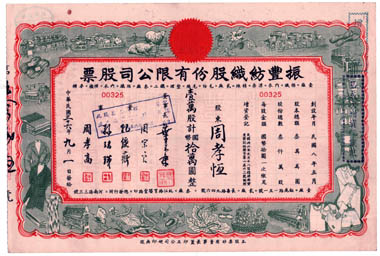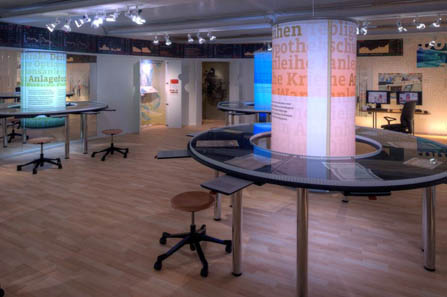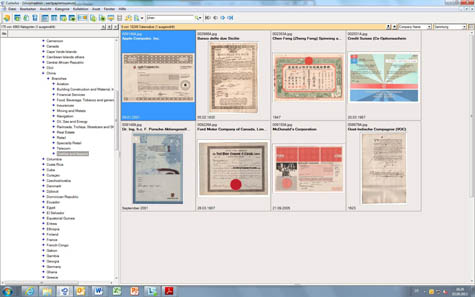September 5, 2013 – To commemorate its ten-year anniversary, the world’s most prominent collection of historical securities is presenting a new type of exhibition: one of modular design that invites visitors to look at the world of securities from different perspectives. In future, a two-part permanent exhibition will bear witness to the origin and spread of the joint stock company as well as explain how financial instruments function. This will be accompanied by a special exhibition that examines subjects of relevance to society, which this year takes the form of the globally networked nature of business. The anniversary exhibitions will feature 140 selected securities spanning the period from the very beginnings of the joint stock company to the present day, all displayed in an area of 300 sqm. Detailed explanations provide background information and outline the importance of each of the exhibits.
In summer 2003 Wertpapierwelt – the Museum of Historical Shares and Bonds – in Olten became the first international museum of its kind to make the world of shares and bonds, not to mention their influence on economic history, accessible to the public. Using historical securities – relicts from a bygone past – the museum illustrates how they interrelate and shows in a generally understandable manner how shares and other financial instruments have always influenced our economy.
The history of capitalism lively illustrated. © Wertpapierwelt – Stiftung Sammlung hist. Wertpapiere, Olten.
The securities world is multifaceted, however. The stock exchange, shares and bonds remain a mystery for many people. How do these financial instruments function anyway? How did the idea of a joint stock company on which our economy is based arise and catch on? How has capitalism and in turn the share changed our world? These key questions have been addressed by Wertpapierwelt -the Museum of Historical Shares and Bonds – to mark its tenth anniversary. The new permanent exhibition displays in its ‘Shares & Co – How financial instruments work’ section the multifaceted nature of financial instruments and their workings. The second section ‘The Story of capitalism – How shares changed the world’ is devoted to the origin and spread of the joint stock company throughout the last 400 years.
Using historical and modern securities, the additional special exhibition entitled ‘The networked business world – Globalization and shares’ provides an impression of just how globally interconnected the economy is with the most varied areas of our lives . This division into three sections enables three multi-layered subjects to be linked up and clearly presented in the exhibition.
Shares & Co – How financial instruments work
The first part of the permanent exhibition addresses all those who would like to find out more about the world of stock exchanges and finances. Because anyone who is not an accomplished market insider will soon find themselves out of depth when reading a newspaper’s financial pages:
Letter of credit of Banco delle due Sicilie from 1830. © Wertpapierwelt – Stiftung Sammlung hist. Wertpapiere, Olten.
shares, bonds, funds, options, futures and whatever else is traded on the stock exchange. The world of finance has witnessed highly varied instruments through the centuries that serve the purpose of generating or investing money. But how exactly do these securities function? How did the stock exchange come about? What is share capital and why are securities no longer printed these days?
Credit Suisse call warrant on gold from the 1980s. © Wertpapierwelt – Stiftung Sammlung hist. Wertpapiere, Olten.
In a reconstruction of the former ring trading in a genuine stock exchange atmosphere, the exhibition explains the workings of a wide range of financial instruments from both past and present. The trading rings of each of the various types of shares, bonds, derivatives, not to mention securities, take turn in providing information of those securities that were important in the past but have since disappeared or been rendered obsolete.
Modern style preferred share of Porsche AG. © Wertpapierwelt – Stiftung Sammlung hist. Wertpapiere, Olten.
Various objects from the world of finance, informative film clips and background information on the emergence of stock exchanges or the physical features of securities – and why they are hardly ever printed today – round off this section of the exhibition.
The story of capitalism – How shares changed the world
While the first part of the permanent exhibition is mainly given over to helping us gain an understanding of the technical and legal aspects of securities, the second part provides us with a thrilling insight into the economic, technological and societal developments that we have witnessed since the invention of the joint stock company in 1602. The share has had a lasting impact on our present world as an instrument that has financed our society’s progress in the last 400 years and served as the basis for the spread of capitalism.
A view into the exhibition. © Wertpapierwelt – Stiftung Sammlung hist. Wertpapiere, Olten.
We are encouraged to take a walk through the centuries along an illustrated timeline. Illustrations of technical advances, key influential figures and events that have shaped the development of our economy accompany us along with typical securities from each period:
The first joint stock company of the world: the Dutch East India Company (VOC). © Wertpapierwelt – Stiftung Sammlung hist. Wertpapiere, Olten.
the emergence of the first joint stock company in the form of large trading companies of the Netherlands and England characterizes the 17th and 18th centuries.
Founder’s share of the world’s first railroad company: Stockton and Darlington Railway. © Wertpapierwelt – Stiftung Sammlung hist. Wertpapiere, Olten.
The global spread of the share went hand in hand with the industrial revolution of the 19th century when small workshops changed into factories and major infrastructure projects such as the construction of the railway needed a way of raising capital among the public. Colonial companies went on to take the idea of the joint stock company to the furthest corners of the world. World wars and inflation as well as the economic miracle of the post-war period dominated the 20th century, at the end of which the ‘new economy’ and the emerging markets of East Asia presented yet another new face of capitalism.
Share of the Ford Motor Company with the signature of Henry Ford. © Wertpapierwelt – Stiftung Sammlung hist. Wertpapiere, Olten.
The securities displayed in this most extensive section of the exhibition show that this development was not without its dark side. They tell not only of the rise of the major companies but also give testimony to ruthless greed and unbridled speculation. Some of the most valuable exhibits in the collection, including several unique items and paper bearing the original signatures of famous commercial pioneers, are displayed here for the first time.
The networked business world – Globalization and shares
Visitors to the special exhibition will find themselves global citizens on networked planet earth. This section of the exhibition deals with the global interdependence of the economy and society. Virtually everybody knows what globalization means and most people have their own opinion on the subject. Many people assume that this is a phenomenon of our current times.
A view into the exhibition. © Wertpapierwelt – Stiftung Sammlung hist. Wertpapiere, Olten.
However, the build-up of a global network between trade and finance, producers and consumers started as early as in the 17th century when the big shipping companies brought tea, coffee, spices and silk to Europe. More and more areas of our daily lives have become ‘globalized’ over time. The exhibition traces this development using securities from various sectors and regions.
Apple Computer and McDonald’s: symbols of globalization. © Wertpapierwelt – Stiftung Sammlung hist. Wertpapiere, Olten.
Why do we need a global financial market? Have fast food and everything associated with it proved a bane or a boon to our consumption patterns? Who makes money on what I buy and can I imagine living without a cell phone and the Internet? Questions like this are characteristic of typical globalization phenomena. Everyone has to answer these questions themselves. By means of securities the exhibition connects selected subject areas of globalization – capital flows, communication, the value chain and our consumption culture. This section of the exhibition gives us various ways of looking at globalization and helps us critically get to grips with the subject while gaining a more in-depth understanding of the interrelationships of our current economic system.
China has become the world’s textile factory. © Wertpapierwelt – Stiftung Sammlung hist. Wertpapiere, Olten.
Thanks to its new modular exhibition design, Wertpapierwelt – Museum of Historical Shares and Bond – meets the expectations of all those visitors who want to just find out more about securities, their history and stock exchange trading. By combining the permanent exhibition with a current issue, a connection is established to our own experience that demonstrates how old shares and bonds are in no way dusty relics of history but have a message for developments in our current times.
The ‘trading workplace’ in the exhibition. © Wertpapierwelt – Stiftung Sammlung hist. Wertpapiere, Olten.
Anyone who would like to find out more after viewing the variety of the securities on display can satisfy their hunger by taking a seat at a fictitious trading workplace set up on two PCs with access to the collection’s database.
The museum’s picture database encourages you to browse through the collection of the collection’s 10,000 historical shares and bonds. © Wertpapierwelt – Stiftung Sammlung hist. Wertpapiere, Olten.
The database contains both the fronts and backs of all the approximate 10,000 securities in the collection, and represents a unique archive of historical securities.
A catalogue is available for the permanent exhibition with illustrations and explanations of all the securities on display, while a separate illustrated accompanying brochure takes you through the special exhibition. English-and French-speaking guides are at your disposal in the museum.
The museum’s picture database encourages you to browse through the collection of the collection’s 10,000 historical shares and bonds.
The curator of Wertpapierwelt presented the museum in CoinsWeekly.
Recently the museum in Olten had an innovative display discussing ‘Women and Finance.’
All further information are available at the museum’s website Wertpapierwelt.





